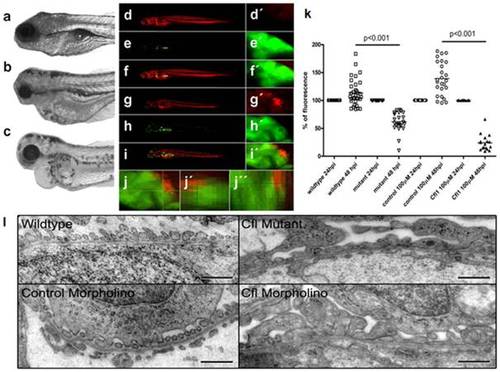- Title
-
Cofilin-1 inactivation leads to proteinuria--studies in zebrafish, mice and humans
- Authors
- Ashworth, S., Teng, B., Kaufeld, J., Miller, E., Tossidou, I., Englert, C., Bollig, F., Staggs, L., Roberts, I.S., Park, J.K., Haller, H., and Schiffer, M.
- Source
- Full text @ PLoS One
|
Knockdown of cofilin-1 expression by both morpholino silencing and viral insertional mutagenesis resulted in altered zebrafish phenotypes, compromised glomerular filtration and podocyte effacement. The phenotype of mutant (b) and morphant (c) embryos were compared to wildtype zebrafish embryos at 120 hpf (a). The mutant and morphant embryos had several aberrant features including edema around the yolk, pericardial effusion, smaller eyes, an arched back, jaw malformation and an absent swim bladder. Control Wt1b-GFP transgenic zebrafish (d–f, d′–f′) and those treated with cofilin-1 morpholinos (g–i, g′–i′) were injected with 70 kDa rhodamine labeled dextrans at 72 hpf and their pronephros imaged 48 hours later. The rhodamine labeled dextrans remained within the circulatory system of the Wt1b-GFP zebrafish with no labeling within the Wt1b-GFP pronephros tubules (d–f, d′–f′). In contrast, in the Wt1b-GFP transgenic morphant embryos (g–i, g′–i′), the vasculature was labeled by the rhodamine labeled dextran, but labeling was also observed within the pronephros tubules (magnification = 180×). (j–j′′) XZ cross section of the collected optical stacks clearly demonstrated the intracellular localization of rhodamine labeled dextrans within the pronephros tubules (yellow). (k) Functional studies demonstrated loss of pronephros function in cofilin-1 knockdown zebrafish embryos. Images of intravascular fluorescence were captured in retinal blood vessels and monitored in individual fish over 24 hours in control, cofilin-1 mutant zebrafish and zebrafish treated with 100µM cofilin-1 morpholinos. At forty-eight hours post injection of FITC-labeled 70 kDa dextrans into the vascular system, the fluorescence intensity in the pupil of the zebrafish increased in wildtype embryos, but decreased in zebrafish treated with 100 μM cofilin-1 morpholinos and cofilin-1 mutants. (l) TEM analysis of podocytes in control, cofilin-1 mutant and cofilin-1 morpholino treated zebrafish demonstrated severe podocyte effacement in cofilin-1 knockdown embryos. While wildtype (upper left) and control morpholino injected (lower left) zebrafish embryos have normal foot processes and slit diaphragm formation, the cofilin-1 mutants (upper right) as well as the cofilin-1 morpholino injected fish (lower right) display foot process fusion and foot process effacement over large areas (size bar: 500 nm). PHENOTYPE:
|

